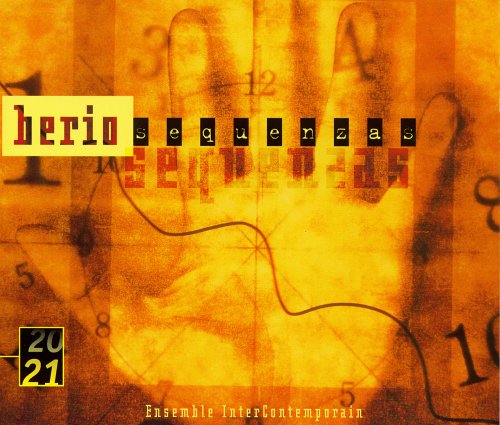Ensemble InterContemporain - Berio: Sequenzas (1998)

Artist: Ensemble InterContemporain
Title: Berio: Sequenzas
Year Of Release: 1998
Label: Deutsche Grammophon
Genre: Classical
Quality: FLAC (image + .cue)
Total Time: 02:37:52
Total Size: 569 MB
WebSite: Album Preview
Tracklist:Title: Berio: Sequenzas
Year Of Release: 1998
Label: Deutsche Grammophon
Genre: Classical
Quality: FLAC (image + .cue)
Total Time: 02:37:52
Total Size: 569 MB
WebSite: Album Preview
CD 1
Sequenza I for flute
Sequenza II for harp
Sequenza III for woman's voice
Sequenza IV for piano
Sequenza V for trombone
Sequenza VI for viola
CD 2
Sequenza VII for oboe
Sequenza VIII for violin
Sequenza IX a for clarinet
Sequenza X for trumpet in C and piano resonance
CD 3
Sequenza XI for guitar
Sequenza XII for bassoon
Sequenza XIII for accordion "Chanson"
Sequenza IX b for alto saxophone
Luciano Berio has always looked at his Sequenzas as building blocks among his other compositions. These solo works, sometimes written for specific performers, exist as elements of other, larger works or as platforms upon which he's built extensive structures. This three-CD set is the first to collect all Berio's Sequenzas, and the performances are peerless.
Berio's writing is, of course, unconventional, feeding off serialism and making complexity sound friendly. Sophie Cherrer's leaping flute on Sequenza I (1958) finds dozens of ways not to shriek, as does Gabrielle Cassone's Sequenza X for trumpet. There are two world-premiere recordings: Pascal Gallois's Sequenza XII for bassoon and Teodoro Anzellotti's Sequenza XIII for accordion (both 1995). Here Anzellotti conjures his playful 1998 recording, Satie on Accordion.
Berio envisions these works as suggestive of polyphony in their architecture and impact, which is to say that the aggressive juxtapositions within a solo work fool the ear into believing that the soloist is a small ensemble. The melodies get multiplied, from initial statements into transfigurations and harmonic variations, making the pieces at once tremendously complex and demanding but also totally inviting. The constancy of these 13 works is evidenced by two of the harmonically richest performances, Benny Sluchin's Sequenza V for trombone (1965, originally composed for Stuart Dempster) and Eliot Fisk's Sequenza XI for guitar (1987-88). The dialogue between density and pinpoint nodes remains a thematic constant, rendered almost in parallel on the various instruments. This is a dynamic, vital document of 20th-century music, one that shouldn't be missed. -- Andrew Bartlett
Berio's writing is, of course, unconventional, feeding off serialism and making complexity sound friendly. Sophie Cherrer's leaping flute on Sequenza I (1958) finds dozens of ways not to shriek, as does Gabrielle Cassone's Sequenza X for trumpet. There are two world-premiere recordings: Pascal Gallois's Sequenza XII for bassoon and Teodoro Anzellotti's Sequenza XIII for accordion (both 1995). Here Anzellotti conjures his playful 1998 recording, Satie on Accordion.
Berio envisions these works as suggestive of polyphony in their architecture and impact, which is to say that the aggressive juxtapositions within a solo work fool the ear into believing that the soloist is a small ensemble. The melodies get multiplied, from initial statements into transfigurations and harmonic variations, making the pieces at once tremendously complex and demanding but also totally inviting. The constancy of these 13 works is evidenced by two of the harmonically richest performances, Benny Sluchin's Sequenza V for trombone (1965, originally composed for Stuart Dempster) and Eliot Fisk's Sequenza XI for guitar (1987-88). The dialogue between density and pinpoint nodes remains a thematic constant, rendered almost in parallel on the various instruments. This is a dynamic, vital document of 20th-century music, one that shouldn't be missed. -- Andrew Bartlett





![Posey Royale - The Real Low-Down (2025) [Hi-Res] Posey Royale - The Real Low-Down (2025) [Hi-Res]](https://www.dibpic.com/uploads/posts/2025-12/1765494723_zbd6vfngwwskb_600.jpg)


